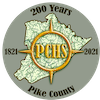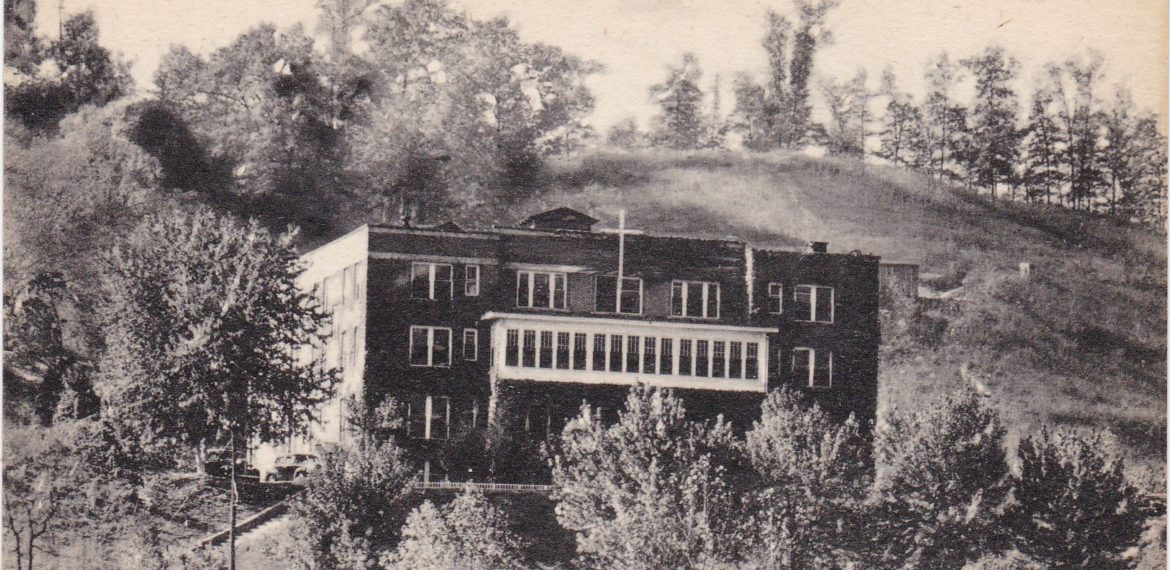THE STORY OF THE METHODIST HOSPITAL OF KENTUCKY, ITS EDUCATIONAL PROGRAM AND HEALING MINISTRY FIFTY YEARS OF PROGRESS 1922-1972
Dedication Prayer
At the Opening of Pikeville Methodist Hospital December 5, 1971 Given by Rev. J. I. Meyer
God, our Father: Words fail to express the warmth and play of our emotion and heart felt thanks that Thou hast brought us to this festive occasion of thecelebration of a noble dream come true. In Thy infinite wisdom, Thou has led us through devious ways as though to test the stability of our character and the integrity of our purpose. Obstacles rose before us that at times seemed insurmountable. But our trust was in Thee, our God, and our faith was well founded. Here and now, we pay tribute to a Little Giant, Eugene Lopez, whom Thou hast assigned to responsibilities elsewhere. He stirred our hearts and minds to action with his vision of a great health center for body, mind, and soul in this valley nestled among these hills. Today, his vision is made visible in this structure of material effects. To that purpose we dedicate every brick and measure of concrete and steel. We hold in tenderest memory all those of that magnificent cent procession who gave themselves without measure to build and maintain the former building on the hill which has been for these many years a House of Refuge for those who suffer. To some of us, it will always be a hallowed spot where an angel, clothed in white, watched beside one precious to us, and gently closed the tired eyes in the softest of all slumbers.
Today, we dedicate this building with all its appointments of beauty, refinement, and culture in the Name of Him, whom Thou hast sent to show to all mankind Thy compassion for the maimed, the halt, the blind, and the fearful. He entreated His disciples and us today to do likewise, assuring us that His works we would do and even greater works. Pour out Thy enriching life giving Spirit, we pray, upon all who contributed in any way to make this hour possible. To the birth of new life, we dedicate this building; to relief of physical suffering, we dedicate this building; to the healing of distressed minds, we dedicate this building; to the cleansing of sin-sick souls, we dedicate this building. But our Father, we know that in a larger way, we cannot dedicate this building except we rededicate ourselves to the healing ministry of those who have gone before us. They labored, and today we enter into their achievements. O Christ, walk Thou these halls; be always present in every room; give skills and compassion to doctor and nurse. Make each worker in office, maintenance, or kitchen know that he, too, is included in this Divine healing ministry. Give wisdom to those who have the responsibility of directing the destiny of this ministry. As time moves ever onward, when like our sires, we and our sons are gone from this earthly scene, may this building cast a healing shadow upon all who enter and may they indeed find doors of hope that never close. In the Name of Chris we pray. Amen.
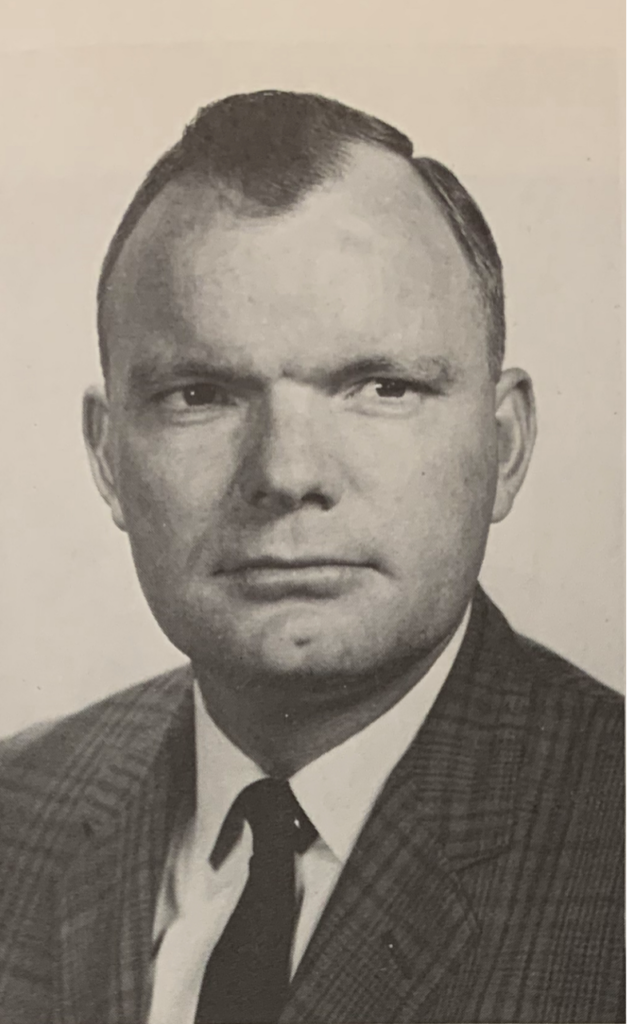
Lee Keene
Administrator
Message From the Administrator, From Dedicatory Address – December 5, 1971
“We move into a new phase of medical history in Pikeville today. I feel certain that with the help of this institution, our community can continue to grow and lead out in the medical services provided for your care. Since our inception, we have followed the original concept of Christianity and have turned no person away from our doors. We will continue to aid all mankind regardless of race, creed, or color; and with the continued combined efforts of our entire community, your hospital will always offer the finest medical services available. It has been a unique privilege to have been able to work with this group of dedicated people and we can all be proud of the results of our efforts.”
Lee D Keene, Administrator
The Story Begins
Great institutions arise in response to great needs. They grow, mature, and become permanent in society as they meet the needs which called them forth. They are the tangible expressions of ideas in the minds of some persons who have the venturesome spirit, patience, and perseverance to turn them into realities. This is true of Pikeville Methodist Hospital.
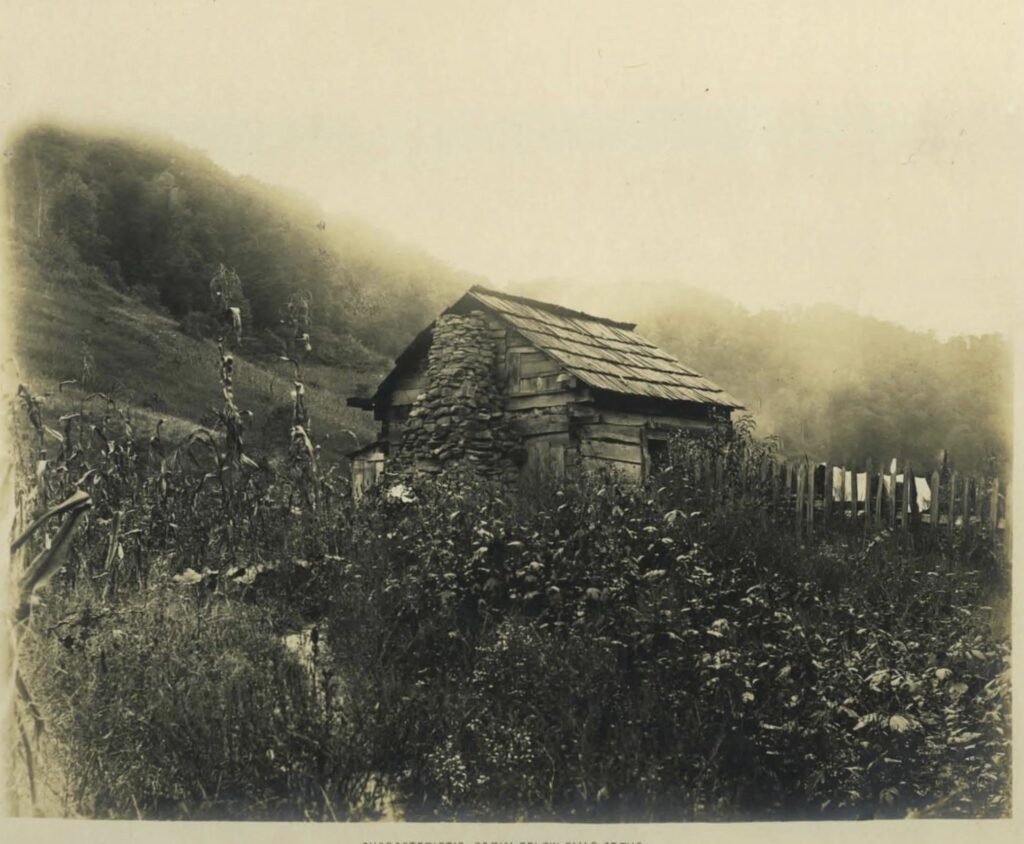
Mountain Scenery
By 1900 industrial leaders had turned their attention to the newly discovered wealth of coal and gas imbedded in the mountains of Pike County, Kentucky. In 1904 they brought the railroad through Pikeville; then extended it the length of the Big Sandy Valley to Elkhorn City. With the building of the railroad, the “Coal Rush” was on. Mines were opened and tipples became a part of the landscape in every direction. In those pioneering days of the industry, mining was a very hazardous occupation. Mine operators induced doctors to come to the mining camps by making them salaries employees. However, there was no hospital in the Valley. The sick and injured had to travel by train to Ashland or Huntington, more than a hundred miles away. Patients often died on the slow moving train before reaching the distant hospital.
At the time the”Coal Rush” was beginning in the Big Sandy Valley, a young man, Thomas B. Ashley, and his wife were students at Union College, Barbourville, Kentucky. They had tried some small business ventures and had done some school teaching but were thinking seriously about making their life’s work in the Methodist ministry.
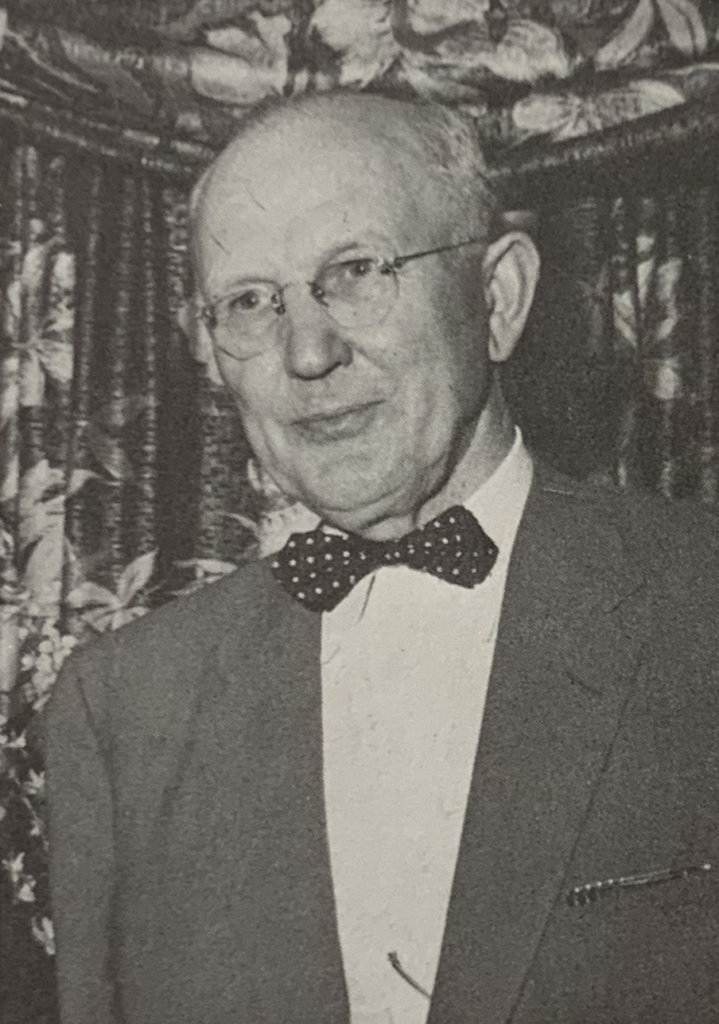
Rev. Thomas B. Ashley
The Kentucky Conference of the Methodist Church was holding its annual sessions in Barbourville with Bishop Thirkeiled presiding. In his Sunday morning Conference sermon, the Bishop exclaimed, “O, that God would put it into the hearts of some young couple here this morning to dedicate their lives to the services of the people in the mountains of Kentucky.”
These words from the Bishop struck a responsive chord with the young Ashley’s. That afternoon, they visited the Bishop and told him that they would be that couple.
When the appointments of the ministries were read, the Ashley’s were sent to open a Methodist Church at Wolfpit, a thriving mining community eighteen miles across the mountain from Pikeville. There, they both taught in the local school and organized a Methodist church.
Ashley’s heart was touched by the lack of facilities to care for the sick and injured, and he began to talk of a hospital for the community. After two years at Wolfpit, the Ashley’s were appointed to the Methodist church at Pikeville. There, he began talking “hospital” to some doctors and businessmen.
Finally, five leading citizens of Pikeville, Dr. R. S. Johnson, Dr. A. C. Bond, George Hames, John W. Call, and H. M. Hoskins, formed a stock company–Pikeville General Hospital, Inc. At their first meeting after incorporation, Ashley was given a share of stock and elected secretary of the Board. Dr. Johnson was elected president. The five incorporations invested $40,000 of their own in the venture and solicited $20,000 more from local citizens.
A building site was purchased from George Hames on Peach Orchard Hill overlooking the City of Pikeville. April 26, 1920, ground-breaking ceremonies were held for the new Hospital building with Dr. Zachariah Johnson and Rev. Ashley turning the first shovels of dirt. After eighteen months, the corporations experienced financial difficulties. Construction on the building had stopped, and it stood incomplete for lack of funds.One morning, Dr. Johnson asked Rev. Ashley, “Preacher, do you know of anybody who would like to buy a hospital?” Rev. Ashley replied, “I have just been elected a Chairman of the Board of Hospitals and Homes of the Kentucky conference of the Methodist Church, I might be able to interest them.”: Rev. Ashley went to Cincinnati and put the situation before Bishop William F. Anderson, the presiding Bishop of Kentucky Methodism, and suggested that the church take over Pikeville Hospital. The Bishop was in accord and heartily approved the venture.
II. Pioneering Days
John F. Ruggles Administration
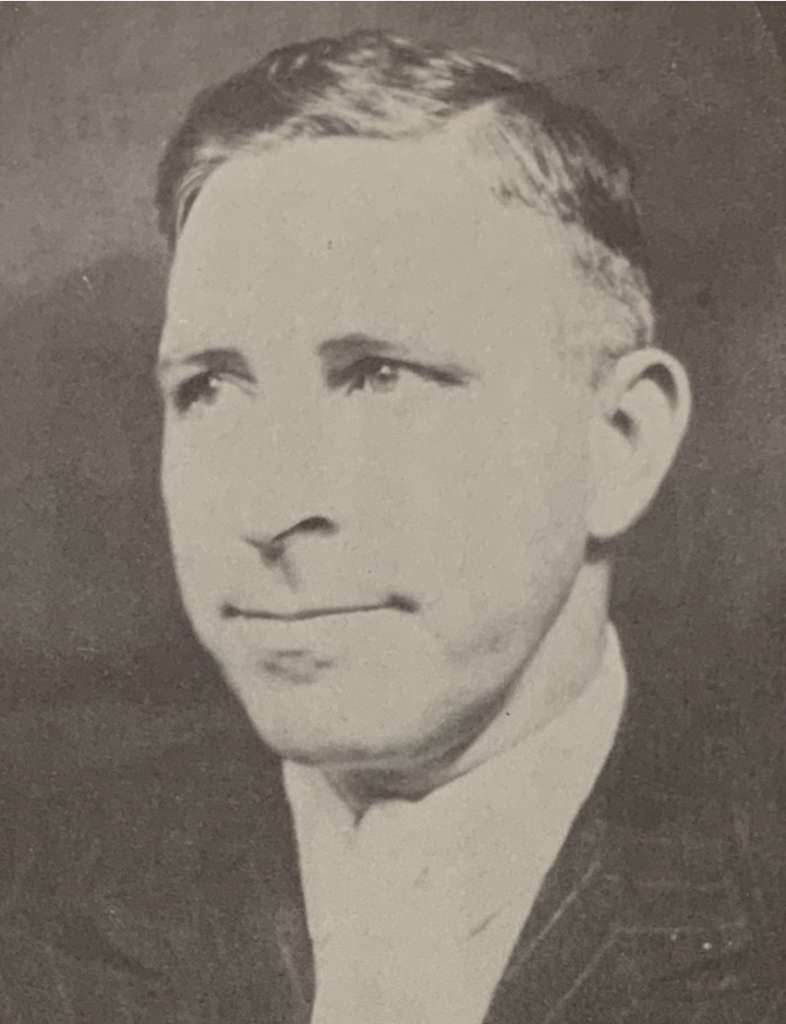
Rev. John F. Ruggles 1922-1925
On January 8, 1921, the Kentucky Conference Board of Hospitals and Homes met at Cincinnati in the Bishop’s office and unanimously voted to ask the next session of the Kentucky Annual Conference to take over the Pikeville Hospital, with its unfinished building, and some $50,000 indebtedness.
In September 1921, the Kentucky Annual Conference endorsed the action of the Board of Hospitals and Homes. On January 8, 1922, the legal papers were signed, and the Methodist Church came into possession of the Pikeville Hospital and incorporated it under the name The Methodist Hospital of Kentucky. That was the first Methodist Hospital of Kentucky.
Rev. Ashley recommended to the Conference the following to constitute the first Board of Directors: H. M. Hoskins, Rev. Thomas B. Ashley, W. K. Elliot (superintendent of Pike County Schools), Fonso Wright, Mrs. Stella Starkey, W. W. Gray, Mrs. Ella R. Keel, Frank Hopkins,
D. T. Keel, K. J. Day, H. S. Damron, and W. E. Johnson (all of Pikeville), and representing the Conference at a large were Dr. S. K. Hunt (superintendent of the Ashland District Methodist Church), Charles W. Connor of Ecco, Rev. F . W. Harrop of Somerset, O. G. Regan of Pikeville, Rev W. W. Shephard of WIlmore, J. B. Coppin of Covington, E. L. Bailey of Hellier, and Rev. J. M. Litteral of Covington.
The first session of the Board was held as an organizational dinner meeting February 20, 1922, in the Pike Hotel at Pikeville. By virtue of his office as Chairman of the Conference Board of Hospitals and Homes, Rev. Ashley called the meeting to order. The following officers were elected: president, H. M. Hoskins; vice president, L. C. Campbell; secretary, Rev. Ashley; and treasurer, W. W. Gray of the First National Bank of Pikeville. Rev. John F. Ruggles, a minister of the Ashland district, was elected business manager (later renamed administrator). C. C Stedman of Cleveland, Ohio, Standardization of Buildings Engineer for the Methodist Church, was employed as buildings consultant. A committee was appointed to solicit funds for the completion of the building.
A local fund drive was first planned by the committee, but the recession of the following the First World War was affecting the economy of the community. Instead of a fund drive, several members of the Board signed notes at the local bank for construction money. J. W. Call, Albert Curtis Bond, M.D H. M. Hoskins
Soon it became evident that the construction would require more money than anticipated and work on the building came to a standstill. In the fall of 1924, the Board decided to complete and open the first two floors. On December 6, 1924, the partially completed building was formally opened. Bishop Theodore Henderson of Columbus, Ohio, new resident Bishop for Kentucky Methodism, was the principal speaker. Dr. N. E. Davis of Chicago, Executive Secretary of the General Board of Hospitals and Homes of the Methodist Church, brought greetings and encouraging words.
A medical staff was organized with Dr. W. C. Gardner as chief. The following doctors were appointed to the medical staff: Dr. Z. A. Thompson, Dr. R. S. Johnson, Dr. R. W. Raynor, Dr. J. C. Preston, Dr. A. G. Osborne, Dr. M. D. Flanary, Dr. S. B. Casebolt, Dr. J. W. Vickars, Dr. E. P. Walters, and Dr. Marion Pinson. The Board of Directors, meeting November 15, had employed Miss Elsie Sanderson of Cincinnati as Superintendent of Nurses. She immediately began a recruiting program and by December 6, had a staff of Nurses properly briefed for the opening of the Hospital.
Miss Sanderson was also elected Assistant Administrator. Rev. John Hughes, Administrator, by necessity spent most of his time in the field, raising funds for the completion of the building, leaving Miss Sanderson in charge of daily operation of the Hospital.
Christmas Day 1924, *Pikeville Methodist Hospital opened for service to the public. That same day, the first patient A. B. Cochran of Pikeville was admitted. Dr. Gardner was the attending doctor.
January 2, 1925. Pike County News
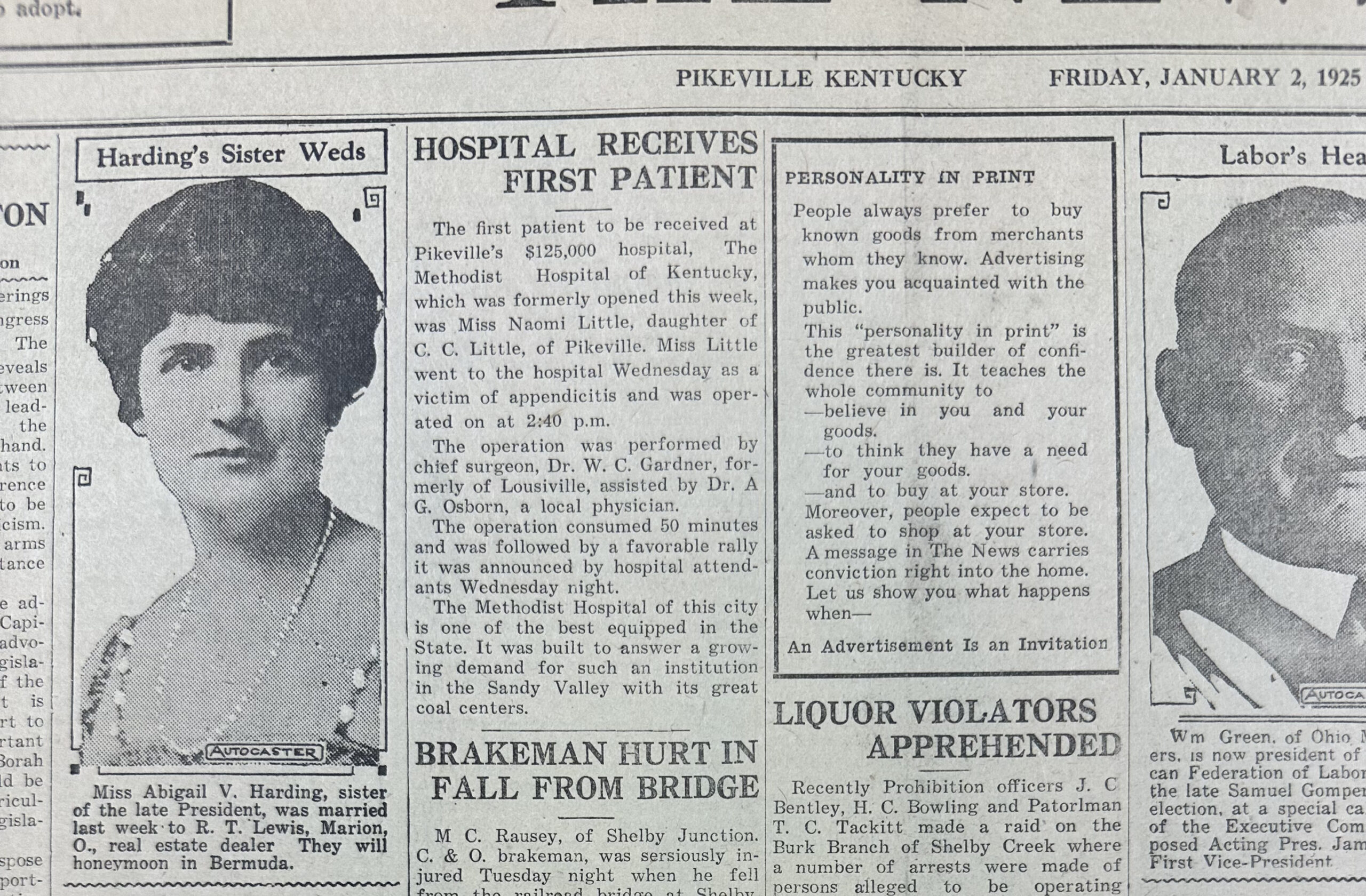
Since none of the medical staff or Hospital personnel had any experience in operating a hospital, the trial and error method was the usual procedure. There were no rules, routine, or precedents to act as guidelines. The situation in hand called for action.
There was never enough money on hand to pay all the bills. The entire personnel, including doctors and nurses, helped in the janitorial service and general housekeeping work. Graduate nurses were paid fifty dollars a month and sometimes were not paid in full at the end of the month.
For several months, there was no water system at the Hospital. Water was brought by hand from a cistern of a nearby neighbor, H. M Hoskins. When a prolonged drought exhausted his cistern, other neighbors gave from theirs.
In the spring of 1925, a deep well was drilled on the Hospital grounds, and water was brought into the building by an electric pump. But even that well did not furnish sufficient water, and the Hospital relied upon friendly neighbors to furnish water until the city could afford to install a public water system.
It was rather fortunate that the Hospital was not crowded with patients at first. Since the nurses were not too busy at the Hospital, they made “good will” tours throughout the county to get acquainted with the people and win their confidence. In many homes, they found those who needed hospital care. The very word “hospital” carried a dread and a fear. They had never seen a hospital, and in their minds, it was a place “where you go to die.”
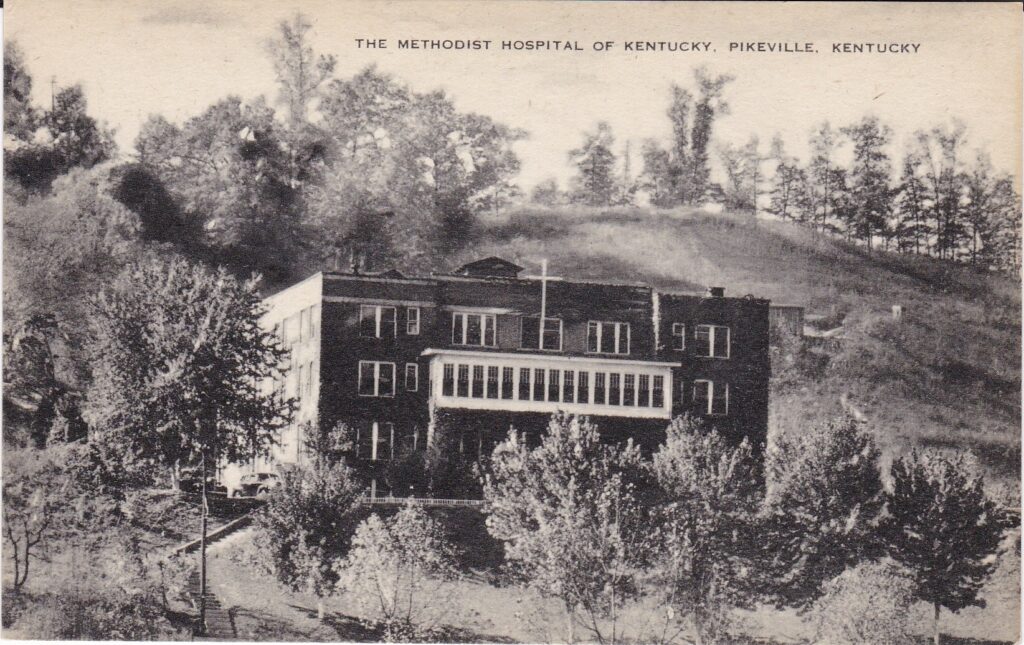
Original Hospital
Gradually the good will tours of the nurses began to break down the dread and fear of the hospital, and a few people from out in the country made the venture. Slowly but surely, the news began to get around that the Hospital was a pretty good place to go to when one had a severe pain in the side, or a mother had given birth to large families without the aid of a doctor. Many had not even had a midwife, and a neighbor woman would give such aid as she had learned from the experience.
Patients were brought to the Hospital via horseback, sled, wagon, boat, train, and improvised stretcher, sometimes a trip of two or three days. This was the case when a nurse on a good will hike discovered in a one-room cabin a mountain family with three children — two boys and a girl, the oldest of the three being eight years of age and the youngest-all of four years. The father was a hopeless dribble from birth. The three children were sick with typhoid and for days had been without any medical care. The nurse reported the situation to Dr. Thomas Ashley, who was minister of the Methodist Church and a member of the Hospital Board.
He and some Pikeville businessmen walked more than twelve miles over the mountains and brought the children to the Hospital. They carried them in stretchers to the river. They then tied two flat boats together and rowed them across the river where an ambulance was waiting.
The children were given thirteen weeks of hospital care, the expense of which was partially covered by contributions from Methodist Churches throughout the Valley. While they were in the Hospital, the nurses took the opportunity to talk with them and their parents about simple rules of family hygiene that would prevent the recurrence of the dread disease.
One morning, after being bathed and placed in a cool, clean bed, one little girl said to the nurse, “There ain’t nary a fly in this house.” That remark spoke volumes. Her home had been accustomed to flies, and none of the family realized that flies were disease carriers.
Because of bad hygienic and sanitary conditions, typhoid was prevalent throughout the mountains. The fact that these children survived did much to win the confidence of the people in the Hospital. Those pioneering days were difficult but glorious days, too. Though the cooperation of doctors and nurses, the Hospital became known throughout the mountains and hollows as a “house of hope and healing.”
However, problems at the Hospital were becoming critical despite the efforts of doctors, nurses, and interested citizens to solve them. This was largely due to a lack of experience on the part of everyone involved in the venture.
The building was unfinished, furnishings and equipment were too crude and meager, and the income was insufficient. To add to these troubles, Rev. Ruggles, the Administrator, had resigned, and Miss Sanderson, the Superintendent of Nurses, who was acting as Administrator, wanted to leave. At the earnest appeal of the Board, she agreed to remain until a replacement could be found.
Meanwhile, a new Bishop— Theodore Henderson of Columbus, Ohio—had Kentucky Methodism in his care. He had made his first visit to Pikeville in December 1924 to open the unfinished Hospital building for service. He was enthusiastically interested in Kentucky Methodism and especially in the mountain region of Eastern Kentucky. He frequently visited the area riding horseback and touring on foot through the mountains and valleys, visiting the mountain homes and the coal mines. He realized the Hospital was a “must” for the people, but he was concerned that the building program was at a standstill for lack of funds. No one seemed to know how to get it started again. The bishop gave his attention toward finding a replacement for Rev. Ruggles. He realized that the man selected must be the one with extraordinary abilities.
S. K Hunt Administration
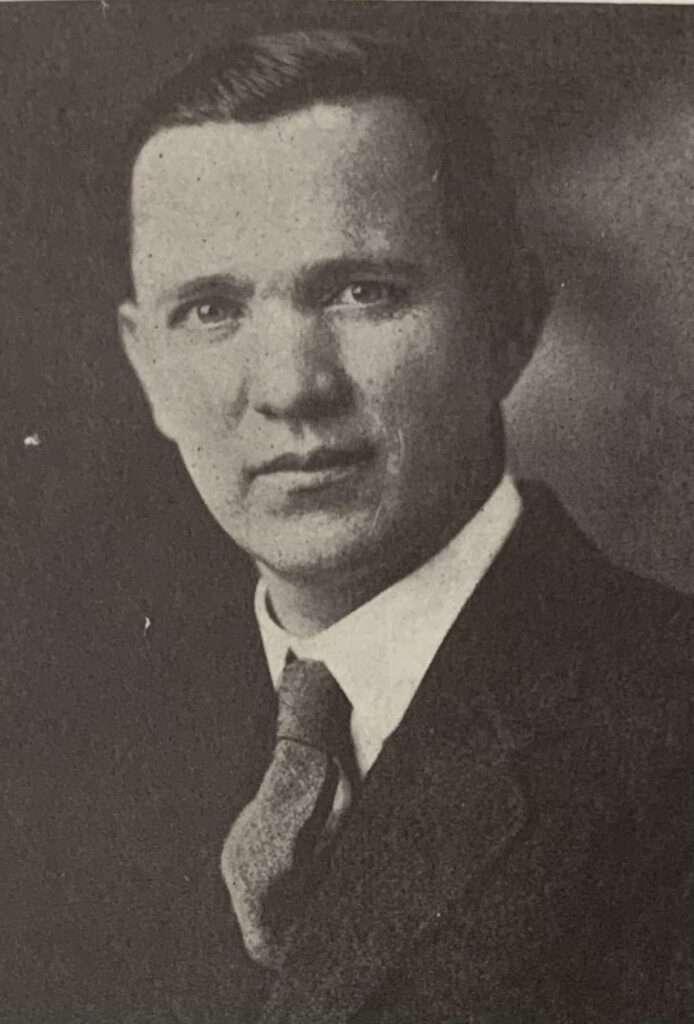
Rev. S. K. Hunt 1925-1936
Dr. S. K. Hunt, Superintendent of the Ashland District of the Kentucky Conference, had shown unusual abilities in administering church affairs in his District. He was a member of the Hospital Board of Directors and was well acquainted with the problems which were becoming more critical day by day.
Dr. Hunt’s children were nearing college age. He had asked the Bishop to relieve him of his active ministerial work at the next session of Conference and appoint him business manager of a college where his children would receive free tuition.
The Bishop, although knowing all of this, asked Dr. Hunt to meet him in Columbus, Ohio. His first words to Dr. Hunt were, “I am appointing you Administrator of the Pikeville Methodist Hospital as of today.”
After Dr. Hunt got his breath, he reminded the Bishop of plans already made for him to become Business Manager of a College, for family interests. “I know,” the Bishop interrupted, “but this is an emergency. We will work out something for your children. The Hospital at Pikeville is in trouble. I want you to take the job and get it moving. I know that you can do it, and I do not know of any other man who can. If you do not take the job, I will have to close it down and sell it. You know that Pikeville needs that Hospital.” Dr. Hunt took the job.
He told the Bishop he had no previous experience as a Hospital Administrator, but he has been an active Board member from the first opening day and was well briefed on the problems. Then too, he was a most versatile man with a keen mind that quickly and accurately gasped and evaluated situations. He also had that sixth sense which executives and administrators must have to be successful in selecting personnel. He drew around him persons within selecting personnel. He drew around hum persons with ability, inspired them to heroic effort, and let them know that he had confidence in them but expected results. Dr. Hunt arrived in Pikeville on the night train June 16, 1925. Miss Sanderson, Superintendent of Nurses and acting Administrator of the Hospital, briefed him on the last developments and left on the next train.
Next day he met with the Board members, and together they began to evaluate the situation. It was determined that $60,000 was required to complete and equip the building. In addition, there were notes in the bank amounting to $50,000, and the Hospital was running a daily deficit in operating expenses. A local fund drive was organized which brought in enough money to pay the most pressing bills for daily operation but not enough to apply to the completion of the building.
In 1928 Dr. Hunt attended the General Conference of the Methodist Church held in Springfield, Massachusetts. There he contacted a group of Investment Bankers and asked for a loan of $65,000. They were interested, and after a visit to Pikeville agreed to the loan to be secured by a mortgage on the property. The building was completed, equipped and in use by the fall of 1928. That gave the community a hospital with a fifty-bed capacity.
Then a more serious problem presented itself. The Chief of Medical Staff brought in from outside was Dr. Vaughn. He evidently was a competent surgeon, but he alienated the other doctors by taking most of paying patients for his own practice. Most of the doctors withdrew from the Hospital and founded a Pikeville Clinic downtown. They succeeded in bringing into their organization Dr. Paul Gronnerud, one of the outstanding surgeons of the United States. He was given the title of Chief of Staff.
Dr. Gronnerud had been partially educated at West Point. After West Point, he entered the University of Louisville Medical School where he graduated with high honors. Dr. Gronnerud took graduate work at Rice University of Medicine; then followed more graduate work in Paris, Rome, and Berlin. After coming back to the United States, he went to Chicago and taught surgery at the University and in other hospitals of the city.
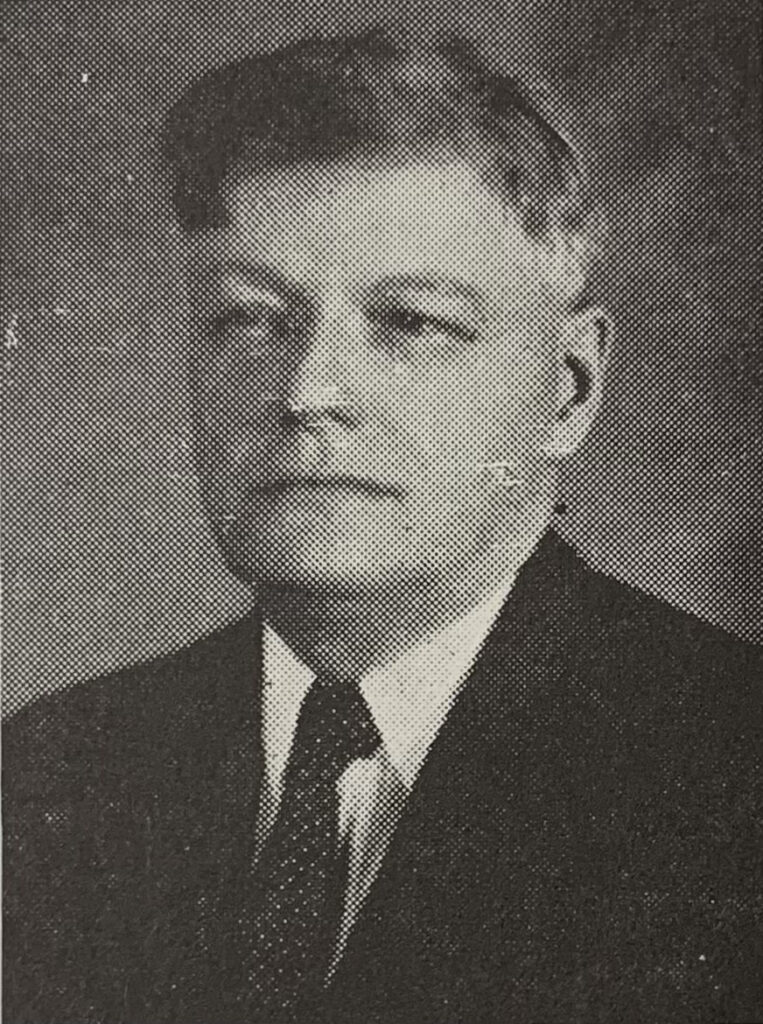
Dr. Paul Gronnerud
He was the first to use catgut instead of silk thread in the suture after surgery. He did the first appendectomy at Rice Hospital, Chicago. He had lectured in medical societies all over the United States. After a few years at Walter Reed Hospital in Washington, Dr. Gronnerud came to Ashland, Kentucky, to be Chief Surgeon in a Doctors’ Clinic. However, a clash of personalities caused him to resign.
Dr. Preston, one of the doctors who had left Pikeville Methodist Hospital for the Clinic, had studied under Dr. Gronnerud at Walter Reed Hospital. When he heard that Dr. Gronnerud had left the Ashland Clinic, he brought him to Pikeville It soon developed that the Methodists had a hospital, but the Pikeville Clinic had the patients. In six months, the Hospital was practically bankrupt. Every major account was closed against it, and the first payment of the mortgage would soon be due.
In the meantime, the depression was being felt in Pikeville. The community thrives on coal, but with factories closed all over the United States, there was small demand for coal. The Hospital’s contract with the miners were working. By 1931 mining was practically at a standstill in the Valley. Every edition of The Pikeville News carried notices of mortgage foreclosures on mines. Some were sold at auction for as little as two percent of their value.
The Hospital had sufficient patients and was making a profit on paper but was unable to collect accounts. One encouraging thing did happen in those dark days. The Doctors’ Clinic downtown had become a very expensive and unsatisfactory enterprise for the doctors. One of them approached Dr. Hunt as to the possibility of closing the Clinic and all the doctors returning to Pikeville Methodist Hospital. Dr. Hunt agreed to take back all the doctors including the new Chief Surgeon, Dr. Gonnerud, but he explained clearly that Dr. Gonnerud could not expect to immediately become Chief Surgeon at the Hospital. The Hospital purchased the equipment from the doctors. This added to the indebtedness but brought back harmony in the Hospital and within the medical circle of Pikeville.
Lack of funds continued to plague the Hospital. When the deficit in operating reached $1,000 a month, the Board realized that something had to be done or go out of the hospital business. It was necessary to raise $16,000 at once for the mortgage payment and at least a few thousand
more for payment to local creditors and Hospital Supply Companies. Dr. Hunt made a trip to Lakeside, Ohio, where the Ohio Methodist Church had an assembly resort. Bishop Henderson was holding a laymen’s retreat there with Methodist men attending from all over Ohio. Dr. Hunt bluntly and plainly laid the facts before the Bishop. He informed him that the Hospital was about to default on the mortgage payment which would bring foreclosure, that credit was entirely stopped, that the Hospital had patients but was unable to collect, as miners were out of work, and that the deficit on operation was running more than $1,000 a month.
The Bishop was stunned by the news. Things at the Hospital were much more critical than he had realized. The depression was at its worst in an industrial state such as Ohio. The Bishop could think of no way to help, but he did ask Dr. Hunt to come to the laymen’s meeting the next morning.
The next morning, he introduced Dr. Hunt saying, “I know that I promised you men that there would be no mention of finances at this retreat. Every man here, and every church represented, is fighting a critical financial battle, but I want to introduce to you Dr. S. K. Hunt of the Pikeville Methodist Hospital. Some of your churches have given financial help to it. I think that you would not want Dr. Hunt to leave without telling his story as he told it to me last night. I present to you Dr. S. K. Hunt of Pikeville Kentucky.”
Dr. Hunt told the story “As it is.” He stressed the need for the healing ministry of the Hospital to Pike and adjoining counties. He told of the struggle to keep the Hospital in operation. He confirmed the loyalty of the employees and professional personnel. Dr. Hunt emphasized the fact that the nearest hospital was more than a hundred miles away, and one had to travel through mountainous country to get to it. He told how the sick and injured people could not afford to go to a hospital in a distant city. He closed by relating two heart-warming hospital experiences:
In 1925, soon after he came to the Hospital, a typhoid epidemic broke out at Wolfpit, eighteen miles across the mountain from Pikeville. One hundred nineteen patients were cared for at Pikeville Methodist Hospital. Only three lives were lost which was considered miraculous considering that typhoid had usually been fatal.
The other story was about an elderly mountain man, Uncle Dan. He had never known a sick day in all his eighty years, so he could not understand the “teasing misery” in his side. True to his mountain pride, he tried not to mention it. Finally, he could endure it no longer! After a family discussion, it was decided that there was but one thing to do, go to the Hospital in Pikeville, many miles away, of which they had been hearing.
About 4 o’clock on a cold winter’s evening, the neighbors set out, carrying Uncle Dan on an improvised stretcher. When they had gotten out of the roughest of the country, he was transferred to a sled. Finally, after much effort by those carrying him, the road leading to the river was reached. The river was crossed, and they came to a railroad stop just in time to catch the last train for Pikeville where an ambulance took Uncle Dan to the Hospital.
His appendix had ruptured, and for days Uncle Dan hovered between life and death. Finally, his strong vitality won. In a few weeks, he was carried back across the mountain to his home where he never ceased to sing the praises of the Hospital which he had barely reached in time. The doctors said that was the first ruptured appendix to their knowledge which had not been fatal.
Dr. Hunt had touched the hearts of the laymen with his simple, dramatic presentation of the needs of the Hospital and the people it served. He remained at the retreat throughout the day and that night. Nearing midnight, some of the laymen came to see the Bishop and asked, “What are you going to do about the Pikeville Hospital?”
He told them he intended to present the situation to the next session of the Ohio Conference which was several months away. The laymen said, “That’s entirely too slow. By then the Hospital will be out of business.”
“What do you men suggest?” asked the Bishop.
The laymen replied, “We have talked this over with the other men. The conferences are well represented here. We suggest that right here, in the morning, after presenting it in open meeting, you appoint a committee to work with you and place an asking on the churches across the Conferences to take care of this critical emergency.”
The next morning the Bishop, together with a committee of the laymen, made out such an asking. It was sent to the churches of the Ohio Conferences as an emergency measure and within days every dollar of the asking was paid. There was money enough to pay the $16,000 due on the mortgage installment and a considerable amount on the other outstanding debts.
With the Bishop’s permission, it was decided to go through the Kentucky Conference in the same manner. Dr. Hunt and other Hospital personnel took pictures, slides, and other informational materials and made a whirlwind visit to the Methodist Churches of the Conference and were successful in getting enough money to care for all operations indebtedness. The economy of the community improved as some of the larger mines reopened, and the financial strain of the Hospital was considerably eased.
In 1932, Dr. Hunt again was a delegate to the General Conference of the Methodist Church which met in Kansas City. When given an opportunity to speak, he told the story of Pikeville Methodist Hospital so effectively that the Conference voted to permit any church in Methodism to designate a portion of its world services contribution to the Hospital. Many churches made such contributions and in a matter of only a few months all bills were paid and there was money in the bank.
Dr. Hunt wanted to open First AId Stations throughout the county. These would be under the care of Nurses as he could spare them from the Hospital. There were always minor accidents and chronic ailments that could be cared for at such a Station. If something serious was discovered, the Nurses could get the patient to the Hospital.
Miss Elnyr Slayton, a nurse at the Hospital, did open such a Station in the Johns Creek community, eighteen miles across the mountain from Pikeville. Later, Miss Slayton went as a missionary to India. After retiring from the missionary service, she moved to Georgia and, in 1971 wrote a letter of her John’s Creek experience to Sally Baker, now a retired hospital nurse living in Pikeville. A part o f the letter which follows tells the story:
“John’s Creek is ninety miles long, just a wee bit short of being a river. The Hospital’s First Aid Station was located eighteen miles up the creek. Someone said, ‘The road was in the creek half the way, and the creek was in the road the other half.’ It was’t quite that bad on the main road, but it too was impassible in winter except horseback. Up the hollows that was literally true; John’s Creek was truly isolated. The small country stores up and down the creeks and hollows had Model ‘T’ trucks that could jump the ruts and make it to Pikeville in reasonably good weather.
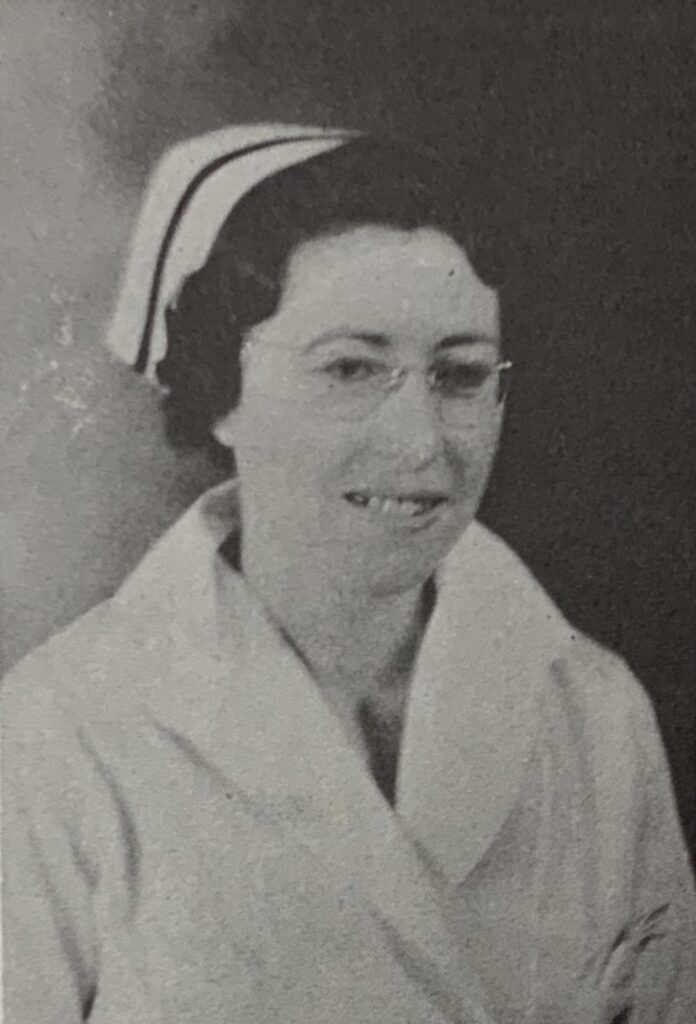
Elnyr Slayton
“Several one room school buildings could be found up and down the creek. Our nearest neighbor, Mr. Bevins, rode horseback nine or ten miles a day to teach in one of them.
“The people did not lack for food. They had large gardens and canned, dried or pickled everything. Every family had a cow, and they raised hogs for their meat and lard. Of course, there were chickens. They traded eggs and butter at the country stores for coffee, sugar, and such other articles that could not be raised in the garden. The stores also carried in stock, Vicks salve, liniments, cough medicines, and many other ‘patented medicines’ that were thought to have healing virtues.”
“Dr. Hunt had long been interested in having an ‘Out Post’ or ‘First Aid’ station on John’s Creel in connection with the Hospital. He had spoken to me about it several times and hinted that he wanted me to go out there and take charge, but I had applied to the Methodist Mission Board to go as a missionary and did not want to get tied down with such a project.”
One day I took a convalescing patient from the Hospital to Canada, Kentucky, another isolated community, and remained with her for a month. When I returned, Dr. Hunt had all the plans made for me to open up the ‘Out Post’ on John’s Creek.”
“The personnel in the set up were: Mrs. Hunt, chief executive, her fifteen year old daughter, myself, another nurse, Nellie Soboloski, Casey the slow but steady steed–out only mode of transportation–Pal the German police dog–chief of police–and a cow and a calf.”
“Dr. Hunt had rented the Dr. Bevins farm so that we could raise a garden. It was the best farm on John’s Creek. Dr. Bevins, a native, had come home from World War I, built a house and had begun practice, but had died shortly after from a heart attack.”
“It di ’not take us long to move in and feel at home, and what a time we had that spring and summer. The house was large and had been very nice but had stood vacant for a long time and needed expensive repairs. We soon had it livable, and with supplies brought from the Hospital, we set up our “Out Post-First Aid Station.’”
“Dr. Hunt secured a Pikeville man just out of the university, Loran Conley, to spend the summer with us and work the farm. We all pitched in and raised a big garden and had plenty to eat. We organized a 4-H Club and took six boys to the 4-H Camp.”
“Clinic was held one day each week. Dr. Hunt had a doctor come out from town for the Clinic, part of the time. The rest of the time we ran to the Clinic ourselves. The Depression was on and there was little or no money to be gotten from the Hospital. Occasionally, I would go to Pikeville and do private duty nursing, to buy drugs and other supplies, then back to John’s Creek.”
“We organized a Sunday School to meet in one of the school buildings.”
“Mrs. Hunt and daughter returned to Pikeville when school began in the fall. Saboloski and I stayed on through the winter. There were always more sicknesses and accidents during the winter. I gave everybody and his brother cold shots. The people had never heard of them. The shots didn’t do much good, for their houses were never really warm and at night were cold. They were always hunting or doing something that took them out in the weather.”
“One day I had a call to come about eight miles up the creek. The patient was a twelve-year-old boy, who had lockjaw. I gave him all the tetanus antitoxin I had and rushed him to the Hospital. He was the first patient in the community to recover from lockjaw, and it was looked upon as a miracle.”
“Another case was a five year old boy who got the full blow of a sharp axe on his hand while helping his bigger brother chop wood. It was late in the afternoon. I applied a tourniquet and stayed with him all night with antiseptics and sedatives. Next morning, I took him to the Hospital on horseback. Dr. Flanary spent four hours on his hand surgery. He saved the hand, although it was cripppled. In time he came to have a good deal of use to it.”
“I did all kinds of first aid work at the Clinic. In fact, I was practicing medicine without a license. The natives along the creek called me ‘the Doctor.’”
“Finally, Dr. Hunt secured a young doctor who was willing to give the Clinic a try out on John’s Creel. I turned everything over to him and left. About that time, I was accepted by the Methodist Mission Board as a missionary to India. I never again saw John’s Creek, but I will never forget the experiences I had there. Those were difficult, hard days, but they were great days too. Later, I discovered that my experiences on John’s Creek taught me so much that I needed to know when a missionary in India.”
When Dr. Hunt took over the Administration of the Hospital, high prices of food and presented a problem. Pike County was not an agricultural county. People had small farms along the creeks and raised most of their own living but had little surplus. Food was shipped in from Cincinnati, more that two hundred miles away and that made it very expensive.
To try and cut food costs, Dr. Hunt rented the Boone Dairy Farm (dairy included), just below town and along the river. A man with a master’s degree in Agriculture from the University of Kentucky was employed to manage the farm. Through his efficient management, the farm produces practically all the staple foods needed at the Hospital.
As the economy improved in the middle thirties, the mines reopened, and it was impossible to find men for farm work. The farm no longer was profitable venture and was turned back to the owner.
Another source of food supply for the Hospital were, the Annual Booth Festivals sponsored by the youth in the Methodist Churches of the Kentucky Conference. Many of the churches were rural or in small towns, and most families had gardens. Woman canned, dried, or pickled fruits and vegetables since it was before the day of electric refrigerators in common use.
In 1930, Dr. Thomas Ashley left the pastorate of the Pikeville Methodist Church to become Superintendent of the Louisville District. Aside from the City of Louisville, the District was rural. With Dr. Ashley in western Kentucky and Dr. Hunt in eastern Kentucky, the Methodist youth were
organized to bring canned and fresh fruits and vegetables to their churches on a certain Sunday in the fall.
Often, churches from an entire county would bring their produce to a central place to be put out on display, prizes were offered for the best. A Hospital truck would pick it up and take it to Pikeville. This project not only provided food for the Hospital, but it also made the churches across the Conference aware of the fact that there was a Methodist Hospital in Pikeville for which they had measure of responsibility.
It was a great day in the Pikeville medical world when Dr. Preston induced Dr. Paul Gronnerud to come to town. When the Pikeville Clinic closed and the doctors went back to the Hospital, they all recognized Dr. Gronnerud as Chief Surgeon, even though for a time he did not have that official title. One doctor remarked, “We thought that we were surgeons, but he taught us real surgery.”
The varied types of surgery demanded at the Hospital challenged Dr. Gonnerud, and what was intended to be a brief visit while looking for a permanent location stretched into years. He remained until his death in 1944. Many people owed their lives to him. He has the ‘feel of a Surgeon.” Many of his surgery cases were carried in the medical journals and often were reported in the newspapers. When he had time, he visited other hospitals to lecture on new techniques in surgery.
Two extraordinary and successful surgeries were done by Dr. Gonnerud in one week. They were not only reported in a number of newspaper dailies but were also written in medical journals and textbooks. One was the removal of a bullet from the brain of a man who had carried it for twenty years. He has been having terrible convulsions. He had gone to other hospitals and had pleaded with doctors for an operation, but they had refused. They told him that it would mean certain death to try such an operation.
Finally, he came to *Pikeville Methodist Hospital. After Dr. Gonnerud examined him, he told him that to attempt an operation would probably mean death as the other doctors had told him. The man replied, “ I would rather be dead than live this way.”
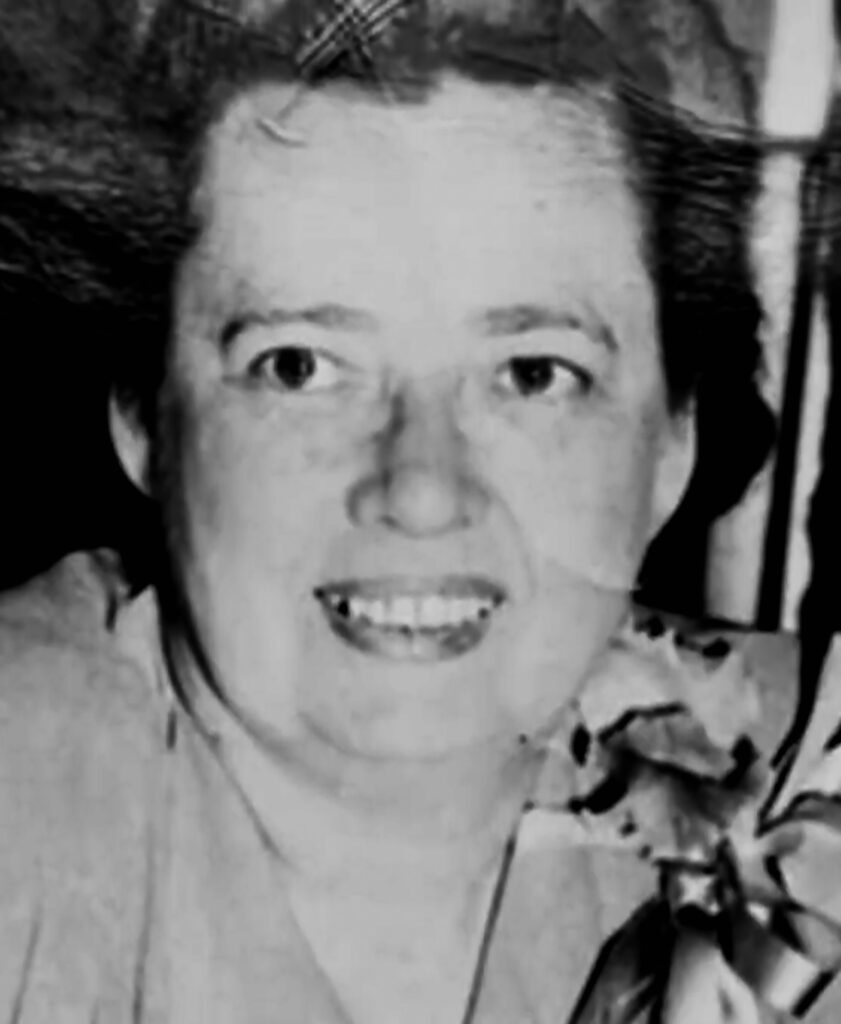
Sally Baker
The Hospital had just installed its first modern X-ray machine. Nurse Sally Baker had recently returned from Chicago where she had done graduate work in X-ray and Laboratory. She pinpointed the bullet by the X-ray. It had gone in his right eye and lodged at the left rear of the brain. Dr. Gonnerud removed it. The man recovered and lived a normal life for several years.
The other was the case of a woman with a tumor. Mrs. May Reynolds Varney of Fishtrap, Kentucky, had carried a 100-pound ovarian cyst for more than eleven years and was known throughout her community as the “tumor woman.” Dr. H. H. Stallard had discovered her and advised her to go to the Hospital for surgery. She did not know that such a thing was possible. She thought that she would not have to lie in bed that way until death. She took the doctor’s advice.
Dr. Gonnerud removed the cyst which contained fourteen gallons of fluid. Fifteen days after the surgery, Mrs. Varney returned home and, according to her own story, was the “happiest woman in the world.”
Bishop William Anderson, in charge of Kentucky Methodism, was in Pikeville when the surgery took place. When he returned to Cincinnati, he reported it to the Cincinnati press for publication, but the newspaper people were skeptical and would not print the story until they had verified it with Dr. Gonnerud and the woman herself. It was released to the United Press and printed in many of the great dailies.
By 1920, Pike County, Kentucky, was recognized as one of the Nation’s great coal producing sections. Coal operators were, of necessity, concerned with public health. Even before there was a hospital in Pikeville, they periodically brought eminent doctors into the area to hold clinics and upgrade health conditions.
One of those who came was Dr. R. W. Raynor. He had been sent to Pike County by the United States Government to investigate an epidemic of trachoma. The Methodist Church has just come into possession of the Hospital and was engaged in the completion of the building.
Dr. Raynor was challenged by the opportunities of service with the area presented. After his tour with the Government, he returned to Pikeville just as the Medical Staff was being recruited for the new Hospital. He joined the Staff and spent the remainder of his life treating diseased eyes. In the Pikeville Hospital, he did the first cornea transplant ever attempted in Kentucky. The patient fully recovered and lives to a ripe old age with two good eyes.

1928
As a step forward in public relations, Dr. Hunt organized the Women’s Hospital Guild in 1929. Mrs. C. G. Evans was the first president and Mrs. Martha Barrett was the first secretary-treasurer. The Guild membership included women of all the churches and women’s organizations of the community. It began, and continues to be, a social and working organization of women dedicated to help the Hospital in every possible way.
Through the years, the activities of the Guild have been many and varied. They have contributed to a large degree to the successful survival of the Hospital as a great institution of healing in the heart of eastern Kentucky’s mountain region. The women have sponsored sales, dinners, shows, and various cultured programs as fund raisers and through the years have given many thousands of dollars to the building fund and the purchasing and replacement of furnishings and equipment. Ever since its organization, women of the Guild have met regularly at the Hospital to mend draperies, curtains, linens, and gowns. They have been especially helpful in supplying materials for the maternity rooms and helping nurses care for new mothers and their babies.
The last project accomplished by Dr. Hunt was the nurses’ home. It had long held high priority upon his list of projects, but there was lack of funds for it. Finally in 1935, a suitable site was purchased close to the Hospital, and with WPA assistance from the Federal Government, a well-planned building was constructed.
Some of the nursing personnel were married and lived in their own homes. Others did not have families in Pikeville and found it difficult to find living rooms close to the Hospital. This was especially a problem for the night shift which changed at midnight. The nurses’ home added to the comfort and safety.
In June 1936, Dr. Hunt tendered his resignation to the Hospital Board in order to become administrator of a hospital in Pennsylvania. It was accepted with deep regrets. His wide leadership over eleven years had established the institution on a firm foundation. He had fully justified the confidence that Bishop Henderson had expressed when he appointed him: “I know that you can do it.”
Rev. O. J. Polley, a member of the Board, moves the following resolution:
“Bishop Theodore Henderson loved Kentucky Methodism of the Big Sandy Valley. The Pikeville Hospital was his pride and joy. During the difficult beginning days, he repeatedly visited Pikeville, attended Hospital Board meetings, gave wise counsel, and financial assistance. Except for his encouragement, it is doubtful whether the Hospital could have survived, but the greatest thing that he did for the Hospital was the appointing of Dr. S. K. Hunt as Administrator in 1925.”
“When Dr. Hunt took over the Administration of the Hospital, he found an unfinished building, a large indebtedness, and little or no credit. His leadership has worked miracles. The building has been completed, debts have been paid, and our assets have increased until today our Hospital has a commercial value of over a quarter million dollars. We are respected by the Conference and the local community, as we give a healing ministry to the people in the name of Christ. All this has been accomplished when our community, with the rest of the nation, has gone through its worst financial depression.”
“The Board of Directors of the Pikeville Methodist Hospital feel that credit should be given where credit is due.”
“Therefore we, the members of the Board of Directors of *Pikeville Methodist Hospital, go on record as extending our Deeping appreciation to Dr. S. K. Hunt, for his brotherly companionship, wise leadership, and untiring labors during these eleven years. We regret his leaving us, and we bid him Godspeed, and assure him that our prayers will follow him in all his future undertakings.”
Ray Ventures seconded the resolution, and it was unanimously adopted by a standing vote and a warm handshake.
Board Members Present:
W. W. Sheppard T. B. Ashley
J. R. Wood
E. S. Shurtleff T. W. Oliver
P. B. Stratton G. H. Hamilton C. N. White
R. A. Venters O. J. Polley
Quite naturally the Board of Directors turned to Dr. T. B. Ashley, really the father of *Pikeville Methodist Hospital, had spent several years as minister to the Methodist Churches in Pikeville and Paintsville. In 1930, he had been appointed Superintendent of the Louisville District of the Kentucky Methodist Conference. He had remained an active member of the Hospital Board of Directors and at the same time had won interest and financial support for the Hospital throughout western Kentucky Methodism.
During the summer months of 1936, Dr. Ashley divided his time between his duties as Superintendent of the Louisville District and Administrator of the Hospital. When the Kentucky Conference met in session in September, the Bishop confirmed the election and officially appointed him to the Hospital. He held that office until 1952. In that year, he retired and moved to Louisville but remained related to the Hospital as field representative throughout the Conference.
Hospital babies at *Pikeville Methodist Hospital, 1937, as part of the celebration of National Hospital Day. Attending were 76 children who had been born at Pikeville Methodist.

Left to right: Caddie Brown, Collie Jane Church, Zelda Fugate, Martha Chandler Shockey, Elizabeth Akers Elliot, ??? Thompson, Chrystal Ronk, Marry Ellis York (Director of Nursing).

Undated photo of the *Pikeville Methodist Hospital Medical Staff: #1, Dr. E. P. Wright; #2, Dr. J. I. Burman; #3, Dr. M. D. Flanary ; #4, Paul Gonnerud; #5, Reverend T, B, Ashley; #6, Dr. J. W. Walters. (Seated left to right) Dr. F. A. Vernon; Dr. J.C. Preston; Dr. A. G. Osborne; Reverend John W. Worthington.
1940
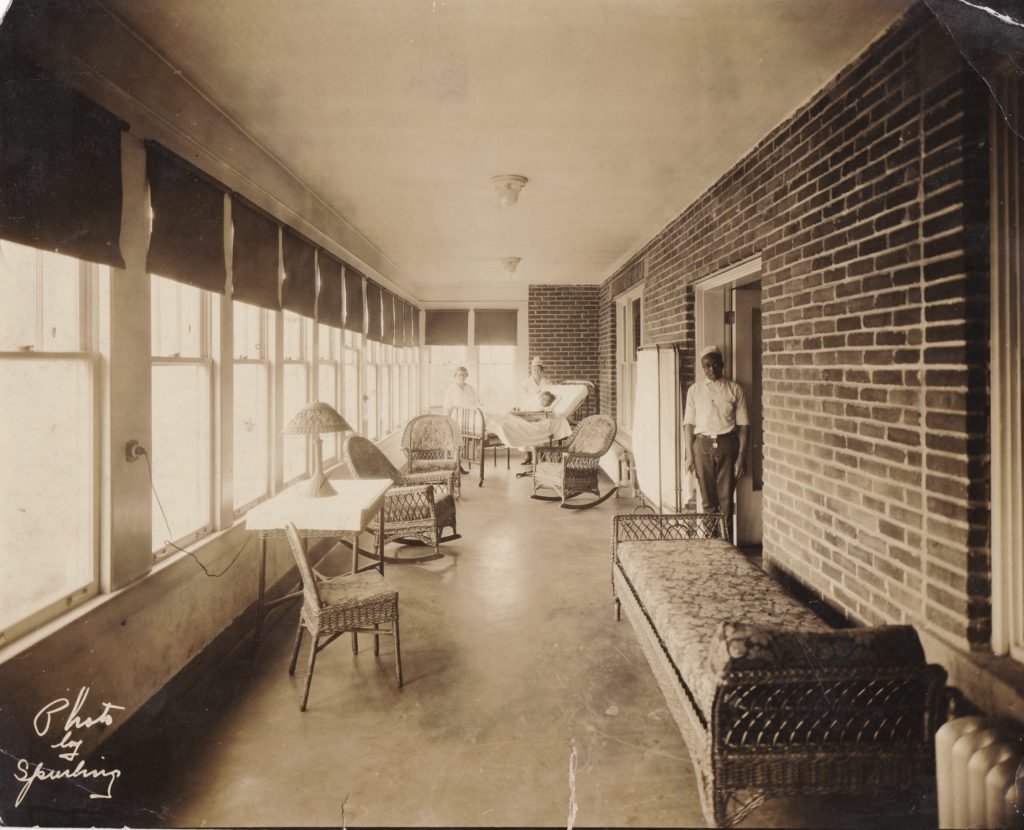
More to come on the First Fifty Years from The Doors of Hope by JJ Meyer
*Note Pikeville Methodist Hospital was operated under the name of The Methodist Hospital of Kentucky for a number of years.
Legal Matters / Promissory Note – JJ Johnson
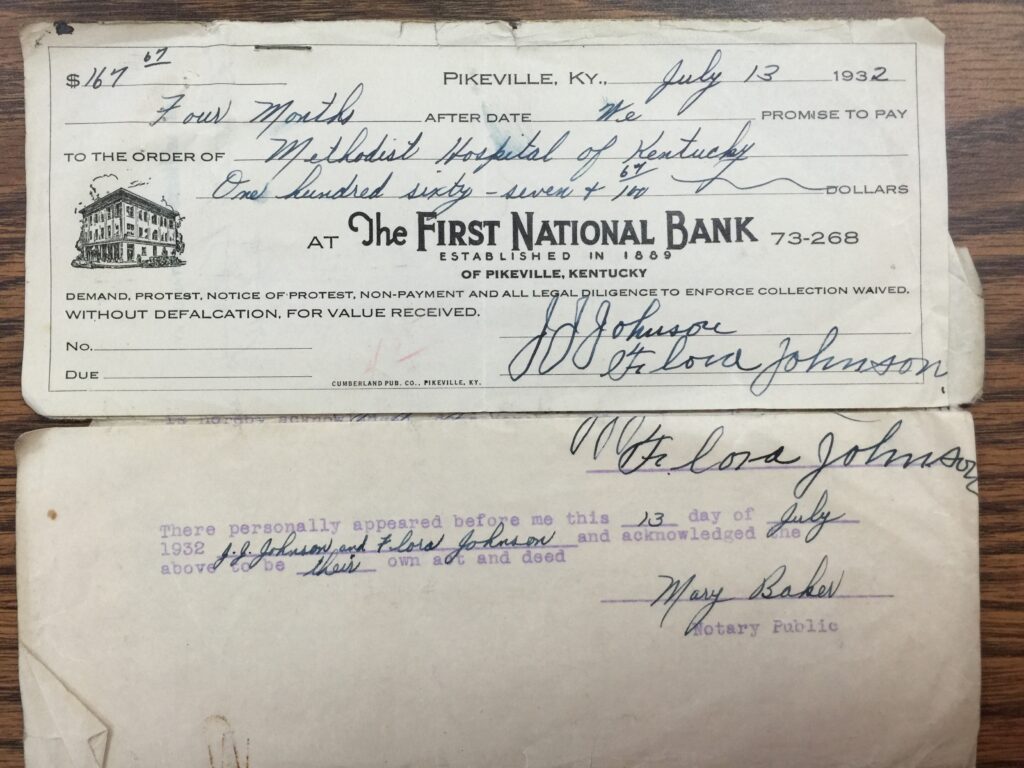
Page 1
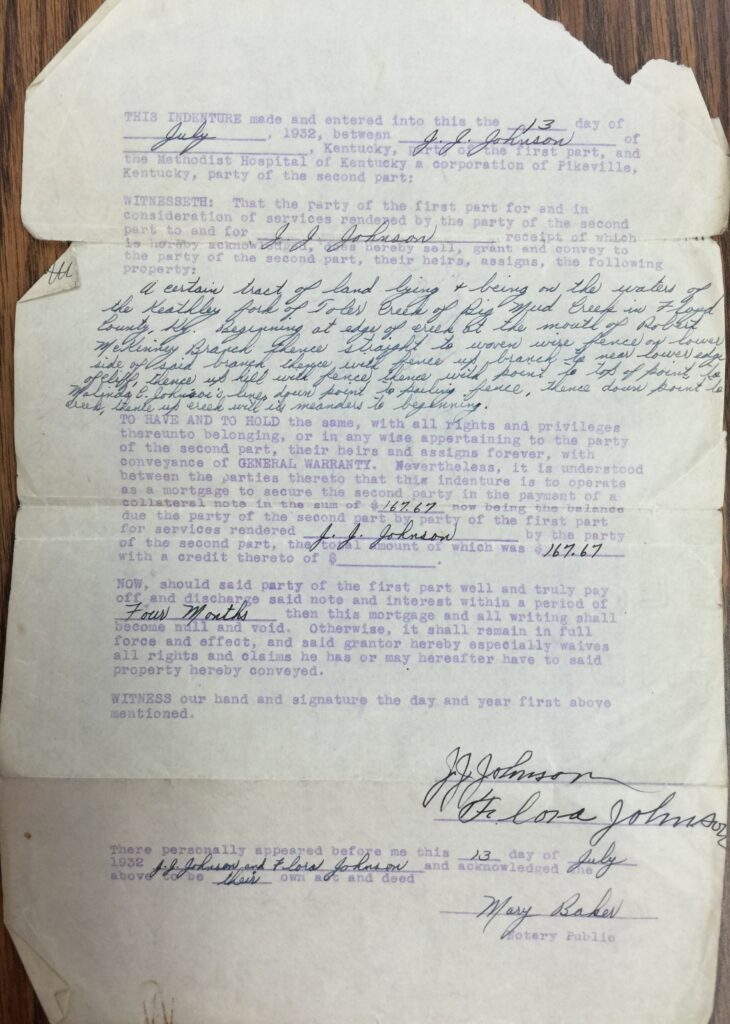
Legal Matters / Promissory Note- FD Adkins
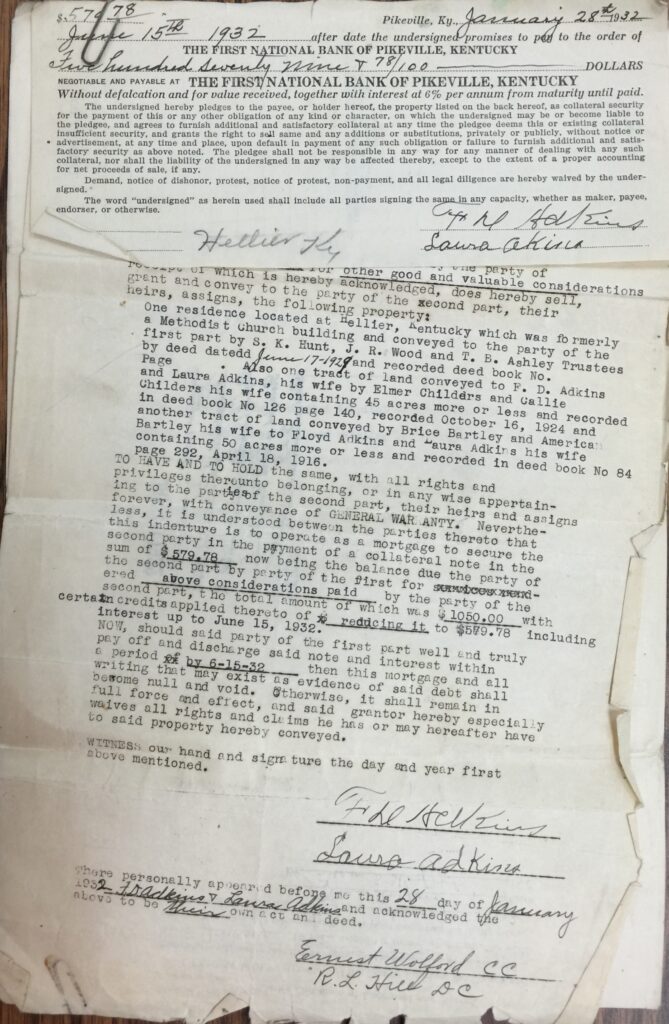
Image 1
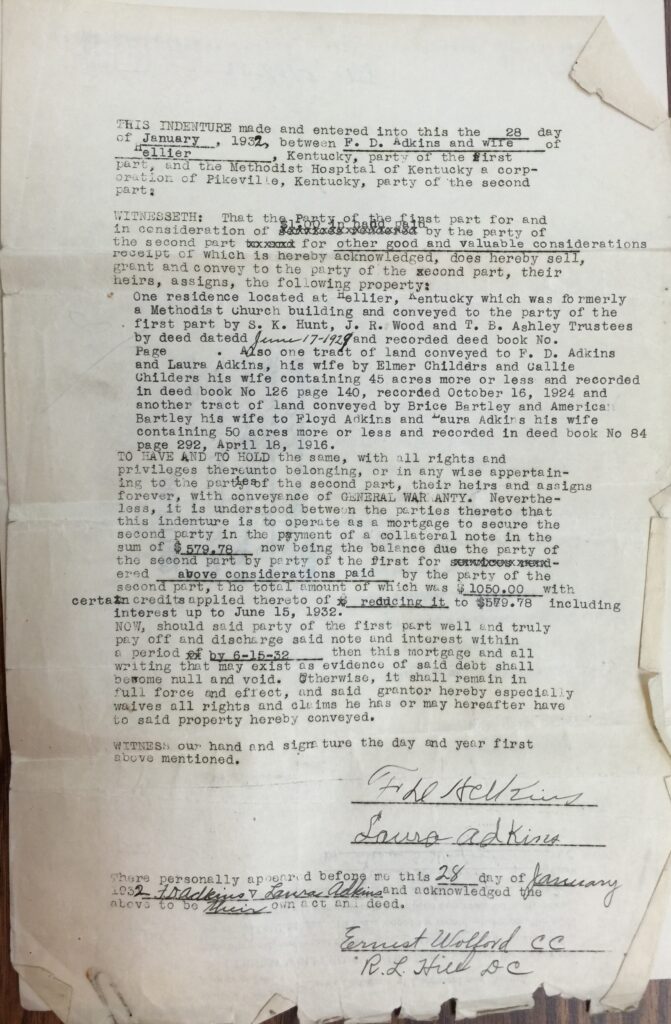
Image 2
